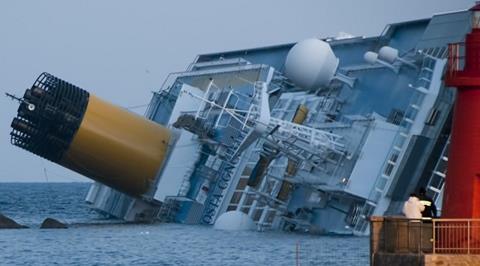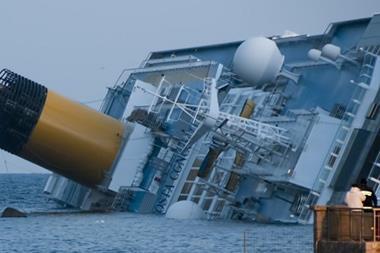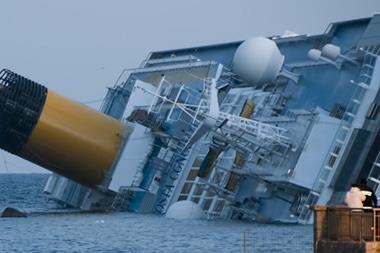£643m loss will do little to raise low investor confidence in insurers, says Moody’s

The size of the loss from the stricken cruise ship Costa Concordia may not be enough to cripple insurers or harden rates, but it will do little to boost investor confidence and improve the poor stock market valuations the insurance industry continues to suffer.
Total insured losses from the disaster are expected to be up to $1bn (£642.8m). The Costa Concordia’s hull alone is valued at $513m, while further claims arising from passenger liability, wreckage clearance and environmental liability will top up the loss figure.
Rating agency Moody’s said in a weekly credit report that the loss will be a drag on insurers’ first-quarter profits, but noted that the losses will be minor when compared with the core earnings power and capital bases of insurers and reinsurers.
However, the agency hinted that the loss would not improve investors’ downbeat view on the industry, particularly reinsurers, as they could bear the brunt of the loss. “The earnings drag from this loss event will impede capital growth for affected firms and contribute to the perception among investors that the reinsurance sector cannot earn its cost of capital,” Moody’s analyst James Eck wrote in the report.
The problem is that, while the Costa Concordia loss is expected to be relatively modest, it comes on the back of a heavy year of catastrophe losses for the global insurance and reinsurance industry in 2011. The industry incurred $108bn of losses, making it the second-highest insured loss year on record after 2005 and the highest-ever economic loss year.
While insurers and reinsurers have largely remained profitable, the losses, coupled with dwindling investment returns in the low interest rate environment, have severely diminished the returns on shareholders’ equity. Opening 2012 with more losses, and thus more lower-than-normal returns, will do little to persuade investors that insurers deserve higher valuations.

Eck pointed out that most reinsurance companies’ share price valuations have been “well below” book value for more than three years, which hurts both them and their clients.
“We continue to believe that the low equity valuations characteristic of the reinsurance sector reduce financial flexibility and increase risk for policyholders and other creditors,” Eck said.
Low valuations are also spurring interest in mergers and acquisitions. A good example is Lloyd’s insurer Hardy, which has at least five suitors. Shore Capital analyst Eamonn Flanagan said the company is trading at a 5% discount to estimated 2012 net tangible asset value. This, coupled with Hardy’s conservative accounting, cautious reserving and good position in key business lines, is making it an attractive prospect for would-be buyers.
But weak valuations are also keeping the number of completed deals down, despite raising interest. They are preventing buyers from using their stock as acquisition currency, and prompting potential sellers to hold out for better times.
The Costa Concordia loss is widely spread around the primary insurance market. The lead insurers, XL, Generali and RSA, are supported by a range of Lloyd’s syndicates and marine industry mutuals, known as protection and indemnity (P&I) clubs.
In addition, Moody’s expects the loss to hit reinsurers harder because primary firms generally buy a lot of reinsurance protection for their marine hull and liability risks, and it usually has low retention levels.
Company loss estimates from the Costa Concordia so far have been sketchy and confined to the reinsurance industry. Munich Re, the world’s biggest reinsurer, said last week it is expecting losses in the mid double-digit million euro range. While the company said it was too early to put a precise number to the potential loss, this suggests an estimate of €40m-€60m (£33m-£50m).
Fellow German insurer Hannover Re on Monday put its Costa Concordia loss at around €30m - although it says this is for the hull only and it is too early to determine the size of the liability losses.
Pass notes: Costa Concordia
How bad is the Costa Concordia disaster?
The Costa Concordia ran aground off the coast of the Italian island of Giglio on 13 January. Some have described the estimated $1bn bill as the worst-ever marine loss. By way of comparison, Espirito Santo analyst Joy Ferneyhough said that the Exxon Valdez oil tanker, which ran aground of the Alaskan coast in 1989 causing a massive oil spill, cost the industry around $500m (£321m), including the spill liability.
How will it affect the marine (re)insurance industry?
The marine industry can take a £1bn loss in its stride, especially given how widely spread it appears to be. But marine and energy as a global insurance class has suffered a number of losses, and reinsurance prices went up on 1 January reflecting this. Costa Concordia will at least help underpin these increases, and could prompt further rises.
How poor are the industry’s stock market valuations?
Reinsurance broker Guy Carpenter says that the average price to book value ratio of the global non-life reinsurance industry is 0.893, compared with a 20-year average of 1.32. The broker says the sovereign debt crisis, the threat of a double-dip recession, heavy 2011 catastrophe losses and concerns about reserving actions are among the reasons for the continued low valuations.
Hosted by comedian and actor Tom Allen, 34 Gold, 23 Silver and 22 Bronze awards were handed out across an amazing 34 categories recognising brilliance and innovation right across the breadth of UK general insurance.














































No comments yet